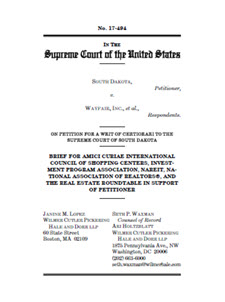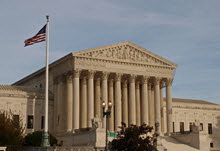The Supreme Court of the United States (SCOTUS) today agreed to address an issue that has long vexed the retail real estate sector, and deprived states and localities of much-needed tax revenue for infrastructure development and other community needs. The nation's highest court "granted cert" in South Dakota v. Wayfair, Inc., to resolve the lingering debate over the constitutionality of collecting sales and use taxes that are due on consumer purchases made over the Internet.
 |
South Dakota v. Wayfair, Inc. is the latest judicial vehicle to seek a ruling from the nation’s highest Court to resolve the lingering debate over Internet sales tax collection. The International Council of Shopping Centers, Investment Program Association, Nareit®, and the National Association of REALTORS® joined a November, 2017 amicusbrief , above, with The Roundtable. |
In Wayfair, the Justices are expected to squarely resolve whether an antiquated legal doctrine known as the "physical presence" test should be overruled. This test exempts on-line sellers from collecting sales and use taxes under the U.S. Constitution's Commerce Clause unless they have an actual, physical retail outlet or other footprint in the state where the purchase is made – thus imposing sales tax collection burdens primarily on traditional brick-and-mortar" stores.
A coalition of real estate groups (including The Real Estate Roundtable) filed an amicus curiae brief with SCOTUS last November, urging the Justices to accept the Wayfair case to challenge pre-Internet decisions from 1991 and 1967 (Quill Corp. v. North Dakota, 504 U.S. 298, and National Bellas Hess, Inc. v. Department of Revenue of Illinois, 386 U.S. 753, respectively). . (See Roundtable Weekly, Nov. 3, 2017.) This pair of decades-old opinions prohibits states from imposing sales and use tax collection obligations on web-based, catalog, and other retailers lacking an in-state "physical presence."
"The direct harm that the [physical presence] rule inflicts on brick-and-mortar retail stores in considerable," the real estate groups wrote in their brief. "Local businesses struggle and increasingly fail to compete against online retailers that can offer customers identical goods for what is in effect up to a 10 percent discount."
The amicus brief explains the "cascading effects" that call for the Supreme Court to revisit Quill and Bellas Hess. Many brick-and-mortar stores "are integral to the social fabric of their communities," and losing them because Internet retailers have a competitive tax collection advantage "increases unemployment and creates a sense of dislocation among community residents."
The outdated "physical presence" rule also causes "lost revenue from sales, property and income taxes" which "threatens the ability of state and local governments to provide much-needed public services" to their communities, the brief maintains. Research data from The National Conference of State Legislatures and International Council of Shopping Centers shows that nearly 26 billion dollars in state and local sales taxes from online sales went uncollected in 2015. (NCSL and ICSC, March 2017)
 |
The Supreme Court is likely to hear oral argument in April and render a decision by the end of June. |
Now that the case moves to the merits phase, a number of advocacy groups are expected to filed a second round of briefs urging a more modern, national standard from SCOTUS to reflect the purchasing preferences and habits of consumers this century. (See SCOTUSblog's Wayfair page.) Since the 1992 Quill opinion, technological advances are now available to address the complexity of administering an online sales tax. Amazon, for example, collects and remits sales tax for consumer transactions in 45 states and the District of Columbia.
With today's cert grant, additional briefing on the Internet sales tax issue is expected throughout the winter and early spring. The high Court is likely to hear oral argument in April and render a decision by the end of June, when it traditionally breaks for the summer.
The International Council of Shopping Centers, Investment Program Association, Nareit®, and the National Association of REALTORS® joined last November's amicus brief with The Roundtable.